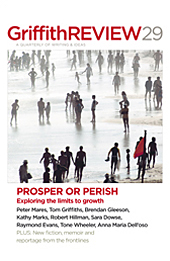Featured in

Buy
$24.95
- Published 20100907
- ISBN: 9781921656170
- Extent: 264 pp
- Paperback (234 x 153mm), eBook

Already a subscriber? Sign in here
If you are an educator or student wishing to access content for study purposes please contact us at griffithreview@griffith.edu.au
Share article
More from author

The planet is alive
EssayI WANT TO take you on a journey from the planet to the parish, from the global to the local, from the Earth in...
More from this edition

No going back
GR OnlineI HADN'T BEEN in Sydney that long and wasn’t used to much of it. As an Englishman everything was more familiar than it would...

Garden cities of tomorrow
EssayA PROJECTED AUSTRALIAN population of thirty-six million people by 2050 is being touted as a figure to fear. The pressure on food supply, lifestyle,...

Sunday Sunday
Fiction‘Politics is the art of shifting trouble from the living to the unborn.’– George Monbiot‘...let no man talk to me of these and the like...
Stay up to date with the latest, news, articles and special offers from Griffith Review.